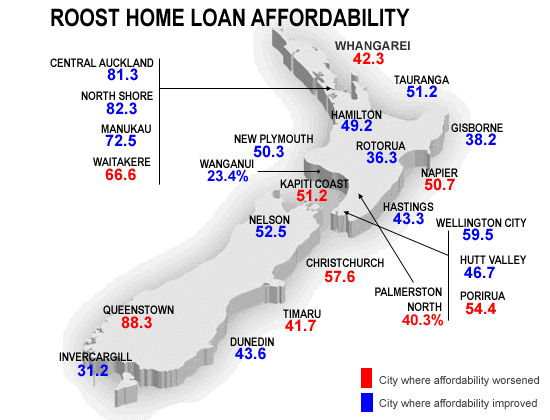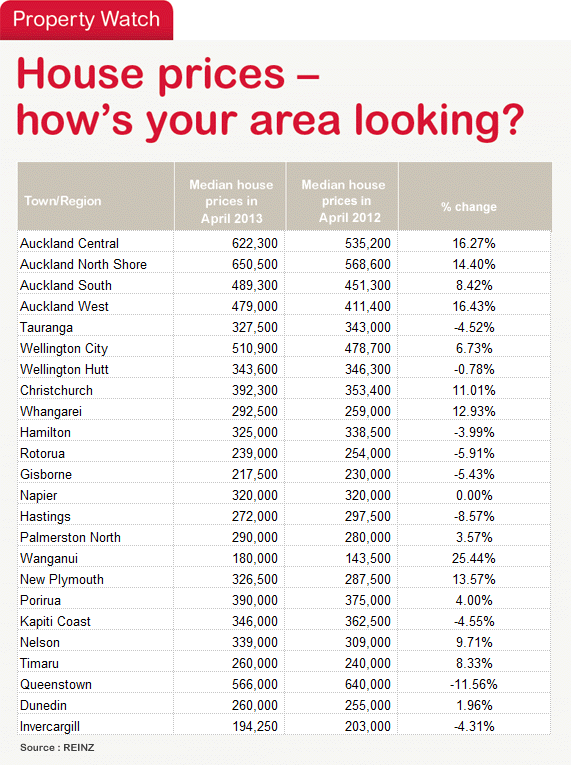
A dip in house prices across most of New Zealand in April helped improve home loan affordability in all regions except Wellington and Manawatu/Wanganui, but the trend in affordability continues to deteriorate as the house price surge in Auckland and Christchurch spreads to other provinces.
The Roost Home Loan Affordability reports showed a slight improvement in Auckland, Christchurch, Northland, Central Otago and Southland after median house prices fell through the autumn month.
But affordability in Auckland and Christchurch remain near their worst levels in three years after a 10% plus surge in house prices in the last year.
Only interest rates remaining near record lows is stopping a further worsening, the Roost Home Loan Affordability reports show.
The reports prepared by interest.co.nz and sponsored by Roost Mortgage Brokers shows it took 81.3% of a single median after tax income to afford a median priced house in central Auckland in April, up from 67.3% as recently as January this year.
This was down from 86.7% in March when the median house price in central Auckland hit a record high NZ$661,600. It fell to NZ$622,300 in April.
Central Auckland affordability is now at its worst level since March 2010, although it remains below its worst ever levels of 107.3% of income required in November 2007 when interest rates were over 10%. They are now closer to 5%.
Nationally, affordability improved by 1.5 percentage points in April from March, which meant it took 55.7% of a single median income after tax to afford an 80% mortgage on a median house, according to the Roost home loan affordability report released today.

Interest rates were broadly flat in April and after-tax wages rose just over NZ$2 per week. A fall in the national median house price to NZ$390,500 from NZ$400,000 was the major driver behind the improvement.
Housing affordability is shaping up as a major economic and political issue over the next 18 months. The Reserve Bank and Government agreed on a toolkit of 'macro-prudential' controls this month that could see the central bank impose limits on high loan to value ratio mortgages. Central and local governments are also moving to address housing supply shortages.
“First home buyers and investors have known about the factors driving home loan affordability for a long time, but now a wider group of policy makers and voters can use tools like the Roost Home Loan Affordability reports to consider the issues," said Colleen Dennehy, a spokeswoman for Roost Mortgage Brokers.
For first home buyers – which in this Roost index are defined as a 25-29 year old who buys a first quartile home – there was also an improvement in affordability, particularly in smaller provincial areas such as Timaru and Invercargill. It remains difficult in the most central parts of the most populated cities.
It now takes 97.9% of a first home buyer's single income to afford a first quartile priced house on the North Shore in Auckland. The most affordable city in New Zealand for first home buyers is Wanganui, where it takes 21.6% of a young person's disposable income to afford a first quartile home.
However, apart from Auckland, Wellington, and Christchurch, it takes around 20-40% of after tax pay to afford an 80% mortgage on a lower quartile priced house. That percentage rises however to 70%, 49% and 58% respectively in those three most expensive major cities.
Any level over 40% is considered unaffordable, whereas any level closer to 30% has coincided with increased buyer demand in the past.
For working households, the situation is similar, although bringing two incomes to the job of paying for a mortgage makes life considerably easier. A household with two incomes would typically have had to use 36.7% of their after tax pay in April to service the mortgage on a median priced house. This is down from 37.6% the previous month.
On this basis, most New Zealand cities have a household affordability index below 40% for couples in the 30-34 age group. This household is assumed to have one 5 year old child.
For households in the 25-29 age group (which is assumed to have no children), affordability also improved, with 22.9% of after tax income in households with two incomes required to service the debt, down from 23.6% the previous month.
Any level over 30% is considered unaffordable in the longer term for such a household, while any level closer to 20% is seen as attractive and coinciding with strong demand.
First home buyer household affordability is measured by calculating the proportion of after tax pay needed by two young median income earners to service an 80% home loan on a first quartile priced house.
-----------------------------------------------------------------------------------------------
Mortgage choices involve making a significant financial decision so it often pays to get professional advice. A Roost mortgage broker can be contacted by following this link »
-----------------------------------------------------------------------------------------------
No chart with that title exists.
Full regional reports are available below:



We welcome your comments below. If you are not already registered, please register to comment.
Remember we welcome robust, respectful and insightful debate. We don't welcome abusive or defamatory comments and will de-register those repeatedly making such comments. Our current comment policy is here.